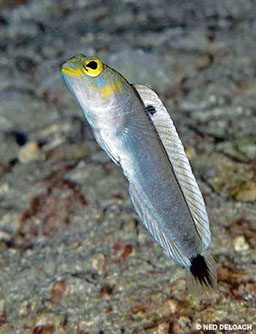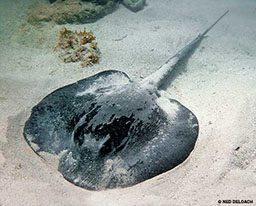
As usual, Anna did her homework. Before we left for a two-week stay in Utila, Bay Islands, Honduras, she scanned the online database of the Reef Environmental Education Foundation (REEF) for fish species sighted around the island in the past two decades. From the 416 fishes recorded, she compiled a “hit list” of a half dozen we had yet to encounter. It included such rarities as the quillfin blenny, yellow jawfish, redcheek goby, Caribbean whiptail stingray and ribbon blenny.
Her most intriguing entry was a seldom-seen little fish endemic to the Bay Islands known as the filament blenny. Additional sleuthing uncovered only a single photo of the species. The image showed the outline of an extremely long fore dorsal fin collapsed along the fish’s back. This amazing piece of anatomy immediately got our attention.
Our goal is not just to find our target fishes but also to photograph them for an upcoming edition of Reef Fish Identification, which we publish in conjunction with our partner Paul Humann. Capturing a good photo of any of the six would be a coup, but as always we have our sights set on them all; we even intend to get a shot of the filament blenny with its dorsal fin extended.

During our first week in Utila we have the boat pretty much to ourselves — a big advantage for targeted species hunting. And our dive guide, Steve Smith, a young Australian chap with the steady eyes and steely determination of an accomplished hunter, is up to the task. Right away he takes us to a mated pair of yellow jawfish at 90 feet and points out a quillfin blenny sitting on a sandy ledge. Between our two target species he shows us a dainty pair of pipehorses, a longlure frogfish and a large-eye toadfish hunkered down inside its den. Things seem to be going too well, and sure enough they are: The following morning the wind begins to blow — not strong enough to keep us out of the water, but stiff enough to keep us out of the shallows where redcheek gobies reside beneath the spines of rock-boring urchins.
The brisk blow sends us on a bumpy ride to the lee side of the island, where filament blennies reportedly shelter inside hiding holes on deep walls. Like other fin-endowed members of genus Emblemaria, such as sailfin and pike blennies, when they’re not out foraging, fighting or scouting for mates the one-inch fish occupy small holes with only their fore bodies exposed. It’s not much of a target when you’re suspended in open water 80 feet down searching for a bean-sized head in a tangle of growth while your decompression computer maddeningly clicks off precious minutes.

Splitting up, we begin scouring the dropoff inch by inch. Ten minutes into the dive Steve raps on his tank. At the end of his finger sits a small, tan head bearing telltale red-banded cirri (filaments). I can’t believe the luck. However, our excitement turns to apprehension as the blenny stubbornly refuses to leave its shelter. But luck keeps coming. As we approach the end of our safe diving limits, the fish pops out of its hideaway and scampers to a nearby sponge. As if on cue, it raises its extraordinary fin high off its back before disappearing into a thicket. Things continue going our way the following day. On a sand plain 70 feet below the unsettled surface Anna finds another rare Emblemaria, this one a ribbon blenny perched inside a piece of coral rubble. We’re on a roll — four fish ticked off our list of six, and we still have a week to go.
But unseasonable winds continue to drive rollers ashore, boiling the rocky shallows where the redcheeks live. Below, 30 feet down, conditions are fine, so Anna and I focus our hunt on the Caribbean whiptail stingray. We make long sweeping swims over sand flats where the large stingrays forage for mollusks. Search as we might, there are no rays to be found; it appears we’re beginning to lose our mojo. “Four out of six isn’t bad,” we console ourselves.
On the final diving day the wind shifts, calming the seas somewhat. From the boat’s morning mooring Anna and I scan the waves breaking along the coastline and decide to give the redcheeks a go. Minutes later we are rolling in the surf among a battlement of shore rock trying to hold ourselves in place long enough to peer inside small depressions where urchins weld themselves to the rock. It doesn’t take long to find our first redcheek perched beneath a cluster of spines. Holding myself in place long enough to focus takes time — an hour, to be exact — but I get the shot. We head for the boat swimming jubilantly side-by-side, feeling like we’ve hit a homerun in the bottom of the ninth. Halfway back I hear Anna squeal. Whirling around I watch her plunging toward a dark, round silhouette lying in a sand chute. It’s our long-lost ray — number six on the list. Make that a game-winning grand slam.

© Alert Diver — Q1Winter 2014